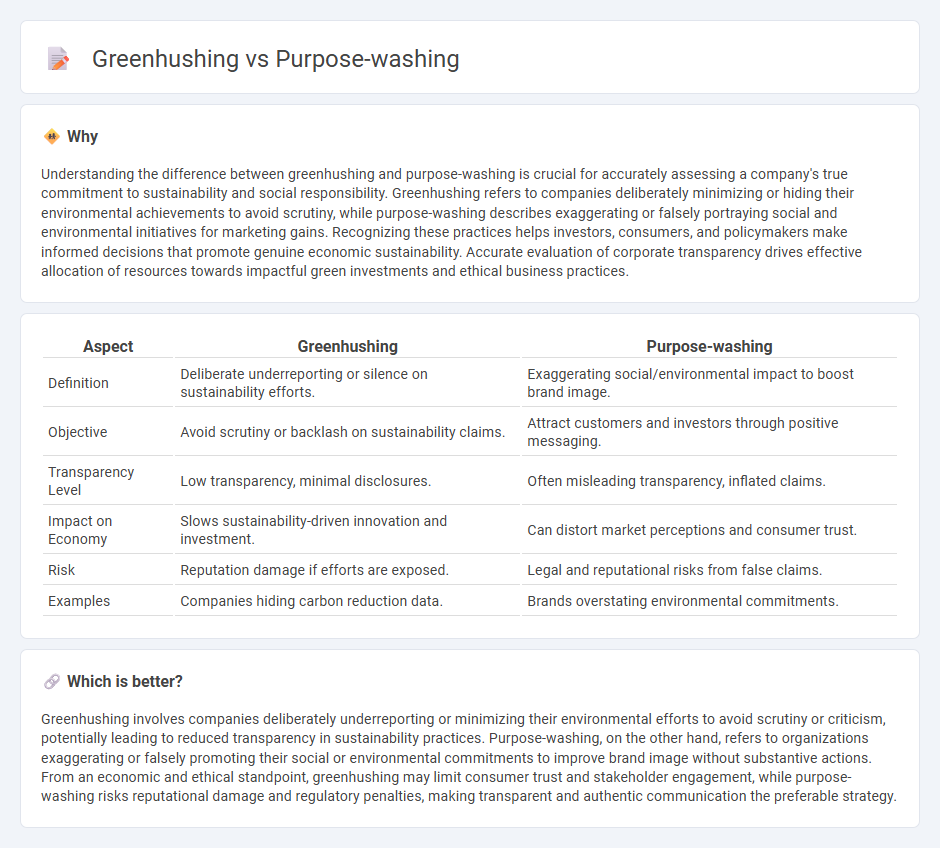
Greenhushing suppresses companies' environmental claims to avoid scrutiny or backlash, while purpose-washing involves overstating social or environmental initiatives for marketing benefits. Both practices distort transparency in corporate sustainability and impact consumer trust. Explore how these trends shape corporate accountability and green consumerism.
Why it is important
Understanding the difference between greenhushing and purpose-washing is crucial for accurately assessing a company's true commitment to sustainability and social responsibility. Greenhushing refers to companies deliberately minimizing or hiding their environmental achievements to avoid scrutiny, while purpose-washing describes exaggerating or falsely portraying social and environmental initiatives for marketing gains. Recognizing these practices helps investors, consumers, and policymakers make informed decisions that promote genuine economic sustainability. Accurate evaluation of corporate transparency drives effective allocation of resources towards impactful green investments and ethical business practices.
Comparison Table
| Aspect | Greenhushing | Purpose-washing |
|---|---|---|
| Definition | Deliberate underreporting or silence on sustainability efforts. | Exaggerating social/environmental impact to boost brand image. |
| Objective | Avoid scrutiny or backlash on sustainability claims. | Attract customers and investors through positive messaging. |
| Transparency Level | Low transparency, minimal disclosures. | Often misleading transparency, inflated claims. |
| Impact on Economy | Slows sustainability-driven innovation and investment. | Can distort market perceptions and consumer trust. |
| Risk | Reputation damage if efforts are exposed. | Legal and reputational risks from false claims. |
| Examples | Companies hiding carbon reduction data. | Brands overstating environmental commitments. |
Which is better?
Greenhushing involves companies deliberately underreporting or minimizing their environmental efforts to avoid scrutiny or criticism, potentially leading to reduced transparency in sustainability practices. Purpose-washing, on the other hand, refers to organizations exaggerating or falsely promoting their social or environmental commitments to improve brand image without substantive actions. From an economic and ethical standpoint, greenhushing may limit consumer trust and stakeholder engagement, while purpose-washing risks reputational damage and regulatory penalties, making transparent and authentic communication the preferable strategy.
Connection
Greenhushing and purpose-washing are connected through their impact on corporate transparency and consumer trust in the economy. Greenhushing involves companies withholding information about their environmental efforts, while purpose-washing entails exaggerating or fabricating commitment to social or environmental causes. Both practices undermine genuine sustainability initiatives and distort market signals related to responsible business behavior.
Key Terms
Corporate Social Responsibility (CSR)
Purpose-washing involves companies exaggerating their commitment to Corporate Social Responsibility (CSR) to appear more socially responsible than they actually are, potentially misleading stakeholders. Greenhushing, by contrast, occurs when firms deliberately underreport or hide their sustainability efforts to avoid scrutiny or backlash. Explore more to understand how these contrasting CSR behaviors impact brand trust and stakeholder engagement.
Sustainability Reporting
Purpose-washing involves companies exaggerating their sustainability efforts in reporting to appear more environmentally responsible than they are, undermining genuine transparency. Greenhushing, conversely, occurs when organizations deliberately minimize or withhold sustainability disclosures to avoid scrutiny or criticism despite making real progress. Explore deeper insights into how sustainable reporting practices can be refined to balance transparency and strategic communication.
Stakeholder Trust
Purpose-washing undermines stakeholder trust by exaggerating a company's social or environmental commitments without meaningful action, leading to skepticism and reputational damage. In contrast, greenhushing involves companies deliberately downplaying or hiding their sustainability efforts to avoid scrutiny or backlash, which can result in missed opportunities for stakeholder engagement and transparency. Explore strategies to build genuine trust through authentic communication and responsible sustainability practices.
Source and External Links
Promises Have a Price - Munich Business School - Purpose washing is defined as communication or organizational actions that mislead people into adopting overly positive beliefs about a company's higher purpose, such as social or environmental goals, without genuine alignment in practices or products, including "saying but not doing" or inconsistent actions.
Purpose-washing - King's College London - Purpose-washing combines greenwashing and woke-washing, referring to companies portraying a societal or environmental purpose that is not reflected authentically in their actions, leading to perceptions of insincerity in claims beyond profit-making.
Purpose-led vs. purpose-washing: what's the difference? - Eleven - Purpose-washing refers to companies that communicate a meaningful purpose in branding or campaigns but fail to back it up with real, meaningful actions, causing consumer distrust and skepticism around corporate purpose claims.
 dowidth.com
dowidth.com